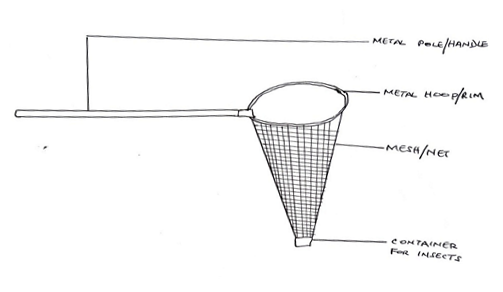Question 1
LIST OF SPECIMENS
Specimen A - thermometer
Specimen B - rain gauge
Specimen C - meter rule
Specimen D - sweep net
Specimen E - wind vane
Specimen F - quadrat
Specimen H - quill feather
Specimen J - palm frond
Specimen P - cockroach
Specimen Q - grasshopper
1. Study specimens A, B, C, D, E and F and answer questions 1(a) to 1(e).
(a) Name one branch of Biology which involves the use of specimens A, B, C, D, E and F. [1 mark]
(b) State one functions each of specimens A, B, C, D, E and F. [6 marks]
(c) Describe briefly how each of specimens B and D could be used. [6 marks]
(d) Make a drawing, 10 cm to 12 cm long of specimen D and label fully.
[8 marks]
(e) Name two organisms each associated with the use of specimens D and F. [4 marks]
Observation
Some candidates wrote ‘ecological’, ‘ecological instruments’, or ‘ecological concept’ instead of ‘ecology’ for the answer to question 1 (a).
Majority of the candidates could not/did not describe how specimens B (rain gauge) and D (sweep net) could be used, some candidates instead repeated the function of the specimens.
Many candidates did not pay attention to the key words, flying, crawling, small as descriptive features of the animals when stating the function of specimens A, B, C, D, E and F. in fact, many candidates could not state the function of specimen F(quadrat).
The candidates that drew specimen D (sweep net) could not label the parts fully and correctly and did not give the titles of the diagram.
Many candidates could not correctly name the organisms associated with specimen F(quadrat).
The expected answers are:
1. (a) Branch of Biology which involves the use of specimens A, B, C, D, E and F
Ecology
(b) Function of specimens A, B, C, D, E and F
A/thermometer: is used to measure temperature;
B/rain gauge: is used to measure amount of rain/rainfall/precipitation;
C/meter rule: is used to measure distance/depth of water/length;
D/sweep net: is used to collect flying insects/any correctly named insect;
E/wind vane: is used to determine wind direction
F/quadrat: is used for population studies/determine the population of small organisms/small plants/crawling insects
(c) Description of the use of specimens B and D
B:
- It is placed in an open area/without vegetation/not under a building;
- On an elevated platform (at least 8cm above ground level) to avoid rain splashes/run off;
- After each rainfall, the amount of water collected in the measuring cylinder is noted and recorded;
- Over a period of time;
- Amount of rainfall is calculated using the formula: Rainfall (cm) = D2 x h;
Time/period d2
(D = diameter of collecting cylinder; d = diameter of funnel mouth; h = height of rain water in cylinder).
D:
- the habitat is chosen;
- the sweep net is held by the handle;
- it is swung in the air to catch organisms/insects;
- the swinging is repeated severally to catch more insects;
- the number and types of insects caught are trapped in the container;
- the trapped insects are counted and recorded.
(d) Diagram of specimen D/sweep net

Title (TL)
Quality (Q)
Clarity of lines (CL)
Size (SZ) (10 cm to 12 cm)
Neatness of labels (NL)
Magnification (MG) (×, ×, ×)
Details (D)
Round mouth net shown (RM)
(Accept oval/oblong mouth)
Long handle shown (LH)
Labels (L)
Wire mesh/net; handle; metal hoop/rim.
(e) Organisms associated with the use of specimens D/sweep net and F/quadrat
Specimen D/sweep net
Butterfly; grasshopper; dragonfly; praying mantis/mantid/any correctly named flying insects.
Specimen F/quadrat
Ant; millipede; beetle; garden snail; Tridax; waterleaf/Talinum; spear grass; grasses/ any correctly named small plant/animal.
